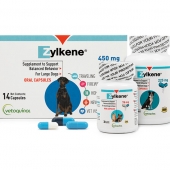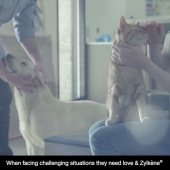While we may think of most of our pets as having a relatively stress-free life, challenging situations can introduce short-term or long-term stress into the lives of our furry friends. Much like their human counterparts, some pets will rebound from this stress easier than others. Regardless of your pet’s stress level, there are things you can do to help transform your home into a “low-stress” environment.
Thankfully, our indoor pets already have their basic needs well cared for. Therefore, we need to turn our focus towards improving other areas of their daily lives.
Make a plan
One of the most important things that we can do is evaluate what a new pet will need before you bring them into the home. Ask yourself: how much activity will this pet need? How will they get along with other pets in the home? What type of ongoing care will they need?
With these questions in mind, we can prepare an environment to meet their needs. This will greatly reduce any stress and lead to the easiest transition into your home.
Keep them engaged
Of course, we need to provide food, water, and shelter. Beyond that, it is important to ensure that they are active and engaged in their daily lives.
For a dog, this might include daily walks or runs, playing fetch in the backyard, and incorporating some favorite toys to play with inside.
For cats, it is especially important not to overlook their level of activity and engagement. Using puzzle feeders or hiding food around the house will help mimic hunting behavior and is far more engaging than simply putting their food in a bowl twice a day. Providing scratching posts and elevated perches can provide additional resources for their daily routine.
This doesn’t have to be difficult or expensive, either. You can start with cutting some entrance & exit holes in cardboard boxes. You can build a small “feline housing complex” if you feel creative and have enough boxes from online shopping! Add some basic homemade toys or inexpensive options from the store. Play around with different options and learn what your cat prefers. Don’t forget to continue trying new things over time, just to keep playtime interesting. The odds are these inexpensive resources will provide hours or days of entertainment and engagement for your feline companion.
Be proactive with known stressors
It’s always good to be prepared. If you know certain situations will stress your pet, start early and build a positive association with the situation. Common stressful situations might include traveling in the car, going to the veterinarian, getting a toenail trim, getting groomed, a new baby in the house, holiday parties, or being left alone during the work day. If these things are not proactively planned for, they are more likely to develop into a problem.
Imagine a situation where a family wants to get a new puppy. They want this puppy to be able to come with them on their family vacations, camping trips, holiday visits, and other family activities.
If the puppy is used to only being in the car for stressful reasons – such as trips to the vet for shots and toenail trims – they will come to associate negative feelings with any car trip, regardless of destination.
Instead, try to make car trips fun. From the very first car trip home, bring treats and interact with the pet throughout the drive. If the family is able, they’ll take time to bring the puppy into the car just to get loved on in the driveway and eventually work up to short drives. The key is to focus on making this time in the car a positive experience. We do not want to push too hard, too fast if they are fearful or nervous in these situations. Take it slow!
And if they need a little extra help, Zylkene® can help keep their pet on an even keel while it learns to deal with new situations.
Over time, that puppy will learn to be comfortable in the car, and even enjoy the ride. That’s good news for you, your family, your pet’s health, and your trips to the vet.
Easier to prevent than cure
Positive associations, like with the car rides mentioned above, have a greater chance of being successful if you start early and in small doses. Zylkene® can help smooth out the bumps in these training periods by helping your pets relax, without drowsiness. Creating positive associations proactively can go a long way toward preventing negative feelings about common life occurrences. As they say, an ounce of prevention is worth a pound of cure.
Simple tips for creating a low-stress environment at home and beyond:
- Provide for their most basic needs.
- Provide additional resources to keep them engaged and active.
- Be proactive in creating positive associations to situations that will occur repeatedly in their life.
- If there is a particular problem for your pet that is related to fear, anxiety, or stress, talk with your veterinarian. They can help you develop a plan tailored to your pet and their behavioral issue.
Resources:
- Your veterinarian!
- A board certified Veterinary Behaviorist. To locate one near you, go to: https://www.dacvb.org/
- For useful information on how to help animals thrive in their home environments, go to: www.indoorpet.osu.edu
- For videos, articles, blogs, etc. on how to recognize signs of stress in your pet, how to read canine and feline body language, etc., go to: www.fearfreehappyhomes.com





